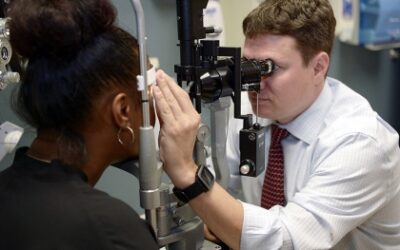What is the role of fungus in allergic airway diseases? VA researchers found that many conditions, including chronic rhinosinusitis (CRS), allergic fungal rhinosinusitis, asthma, allergic bronchopulmonary mycosis/aspergillosis, and cystic fibrosis (CF have a shared immunological signature. In some cases, nasal polyps can occur.
A Rare Cancer Prompts Sleuthing at the VA; New Options for MDS
VA researchers solved a mystery involving younger veterans who developed unusual and deadly cancers. They determined that patients currently using certain drugs, thiopurines, had triple the risk of myelodysplastic syndrome (MDS) and acute myeloid leukemia (AML) on an adjusted basis compared to those never exposed. The risks resolved with discontinuation.
Smoking Cessation Success Rate Low Even in Veterans With Lung Cancer
With a range of smoking cessation program, the VA is having some success reducing the percentage of veterans who use tobacco. Still, data show that veterans find it hard to quit, even when they have been diagnosed with lung cancer and continued smoking affects their overall survival.
Early Colonoscopy in Veterans With IBD Lowers Overall Mortality
Well-timed colonoscopy appears to improve overall survival in inflammatory bowel disease patients, but many VA patients aren’t getting screened regularly. A new study supported current VA practice guidelines that recommend colonoscopy intervals from one year to three years among patients with IBD who have extensive colitis or left-sided colitis.
Risk Factors Change for HCC With More Effective Hepatitis C Treatment
Risk factors for hepatocellular carcinoma have undergone dramatic changesin recent years. Metabolic conditions such as obesity and diabetes, as well as associated nonalcoholic fatty liver disease, now sit at the top of the list. Alcohol use disorders also are on the increase, fueling alcoholic liver disease and alcoholic cirrhosis. At the same time, however, with more effective treatment and prevention, hepatitis C and hepatitis B infections have decreased in prevalence.
VA Researchers Look at Role of Estrogen, Menopause In Elevated Rates of Glaucoma in Women
Women represented less than 10% of U.S. veterans in 2017, according to the National Center for Veterans Analysis and Statistics, but the number of women veterans receiving VHA care has increased by 22.1%, from 423,642 in 2014 to 517,241 in 2018 and is predicted to burgeon even more in the future. That’s why studies such as one examining the role of estrogen and menopause in glaucoma are so important to the VA.
Diabetes Patients With CKD Use More Insulin, Even Though Combination Raises Risk of Severe Hypoglycemia
Conventional wisdom has suggested that insulin requirements go down with advanced chronic kidney disease in Type 2 diabetes patients. That does not always appear to be the case, however. A recent study found that patients with both T2D and CKD are at much higher risk of severe hypoglycemia with insulin use.
In-hospital Continuous Glucose Monitoring Protects Patients, HCPs
Hyperglycemia and diabetes are common in hospitalized patients. Managing that amid the restrictions of the COVID-19 pandemic, including the more recent staff shortages, has been extremely difficult at the VA and elsewhere. Increased use of continuous glucose monitoring has helped the situation.
Genetic Changes Increase Likelihood of Poor COVID-19 Outcomes in Chronic Lung Diseases; Environmental Exposures, Lifestyle Put Veterans at Higher Risk
Because they are molecularly susceptible to SARS-CoV-2, patients with chronic lung diseases appear to be primed for worse outcomes after infection, through the dysregulation of genes related to viral replication and the innate immune response in epithelial cells, and basal differences in inflammatory cell gene expression programs, according to a new study. The authors cautioned that patients with idiopathic pulmonary fibrosis are most at risk but the greater danger also affects those with chronic obstructive pulmonary disease and interstitial lung disease.
Bipolar Disorder Often Misdiagnosed as Major Depression, Leading to Improper Treatment
Nearly 70% of bipolar patients are initially misdiagnosed and a third or more still haven’t gotten an appropriate diagnosis a decade later. Making the situation even more troubling is that many bipolar patients are being treated for major depressive disorder and receiving antidepressants alone – therapy that is suspected of actually destabilizing mood.
Did Military Toxic Exposures Increase Risk of AML, MDS in Veterans?
The debate continues a half-century after Agent Orange use ended over whether exposure to the herbicide in Vietnam and elsewhere contributed to the development of acute myeloid leukemia and myelodysplastic syndromes. A recent article from Yale researchers raised the issue anew.
Co-Morbid Conditions Make Veterans’ Alcohol Use Disorder Even Riskier
While alcohol use disorder is common among U.S. veterans, it often doesn’t stand alone. Instead, AUD is frequently found as a co-morbid condition with other psychiatric diagnoses or post-traumatic stress disorder. The combinations make the condition riskier and harder to treat.
Tracking How Much COVID-19 Vaccination Was Distributed, Lost in Early Rush
In an effort to improve future efforts, data has been made available on initial COVID-19 vaccine shipments and wastage across the United States, which occurred shortly after those vaccines became available.
Safety Procedures Aren’t Always Followed at DHA Facilities
Dez Del Barba was only a short way into Army basic training at Fort Benning, GA, when he began to experience escalating pain in both legs. Physicians wrote it off as simple muscle soreness.
Obstructive Sleep Apnea in Aging Women Tends to Differ From Men
Obstructive sleep apnea, a disorder associated with persistent collapse or narrowing of the upper airway during sleep, has been linked to several detrimental outcomes including excessive daytime sleepiness, high blood pressure, neurocognitive decline and metabolic disorders.
Smoking History Affects Overall Survival in Women With Breast Cancer
Largely because of its association with conditions such as lung cancer and cardiovascular/pulmonary diseases, cigarette smoking is the leading cause of preventable morbidity and mortality in the United States, with about 480,000 deaths each year attributable to the habit.
Future Employers Might Not Know About Problem Clinicians Fired by VA
A recent investigation by the VA Office of the Inspector General (OIG) found widespread noncompliance by VA facilities in reporting healthcare professionals whose conduct or incompetence led them to be fired to state licensing boards (SLB) or the National Practitioner Data Bank (NPDB).
Costs of Severe Drug Reactions Resulting in Hospitalization at the VHA
Each year, approximately 2 million serious adverse drug reactions (ADRs) occur in the U.S. and are responsible for around 100,000 deaths, according to the Food and Drug Administration’s Center for Drug Evaluation and Research.
Niacin Supplements Appear to Help PD Motor Function
Can niacin supplementation improve motor symptoms in Parkinson’s disease patients?
Altered Cholinergic Innervation in New Parkinson’s Patients
While evidence is strong that altered cholinergic innervation plays a key role in cognitive impairment in Parkinson’s disease (PD), at least in advanced stages, less is known about the relationship between cognitive impairment and cholinergic innervation early in the disease.
Adverse Events Predict Cognitive Decline After Brain Stimulation
In a small subset of Parkinson’s disease patients, deep brain stimulation is linked to statistically and clinically significant cognitive declines.
Veterans Suffered Myriad Mental Health Outcomes After COVID-19 Infection
More than two years into the pandemic, studies are showing the long-term effects COVID-19 can have on the heart, lungs, kidneys and other organ systems.
Burn Pit Exposure Legislation Likely to Get Senate Vote Soon
The Honoring Our PACT Act–the comprehensive toxic exposure legislation that passed with broad bipartisan support in the House–is looking increasingly like it will get a vote in the Senate.
Chronic Inflammation in mTBI Affects Sleep Quality
Occurring immediately after mild traumatic brain injury (mTBI), elevations of inflammatory cytokine levels can persist for years and are associated with neuropsychological outcomes, including depression and PTSD symptoms.
Daily Physical Activity Helps Less Serious Insomnia
An often recommended lifestyle intervention for insomnia is physical activity (PA). It is not clear, however, that more activity benefits patients across the range of insomnia severity.
Anger Contributes to PTSD Sleep Disorders
Anger is a major contributor to sleep problems among military servicemembers with post-traumatic stress disorder.
Most, but Not All, Hospital Acquired Infections Rose at VA During Pandemic
The COVID-19 pandemic’s effect on hospital acquired infections in various types of VA acute care was a mixed bag, although, overall, many rates increased, according to a new study.
Hospitalized Male Veterans With COVID-19 Didn’t Improve With Androgen Suppression
A potential protective role for suppression of the androgen receptor (AR) against COVID-19 incidence and severity has been observed in some retrospective analyses.
Milwaukee Nurse Identified Syringe Problem That Led to Recall
In August 2021, the medical device manufacturer Cardinal Health recalled approximately 267 million of their prefilled saline syringes. The syringes had been found to reintroduce air into the syringe after it had been expelled, which could have resulted in the injection of air into blood vessels, leading to serious injury or death.
COVID-19 Outbreak During Army Training Exercise Offers Prevention Lessons
Extreme weather during a field training exercise forced more than 100 Joint Base Lewis-McChord soldiers to shelter closely together last year and led to an extensive outbreak of COVID-19.




